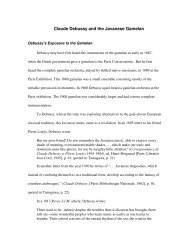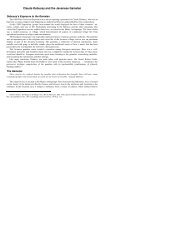Music Preference 1 - Brent Hugh's personal and business web pages
Music Preference 1 - Brent Hugh's personal and business web pages
Music Preference 1 - Brent Hugh's personal and business web pages
You also want an ePaper? Increase the reach of your titles
YUMPU automatically turns print PDFs into web optimized ePapers that Google loves.
<strong>Music</strong> <strong>Preference</strong> 17<br />
Berkeley, 1997). Neural networks have even been used to model the specific cognitive changes<br />
that occur with aging (Balota & Duchek, 1992).<br />
Experience with neural networks gives an intriguing possible explanation for the decreasing<br />
changeability of preferences that comes with age. The neural network model suggests that "our<br />
decreasing ability to accept new things is essential in the making of sophisticated taste" (Mok,<br />
2000, para. 2).<br />
A neural network, like a human, learns by experience <strong>and</strong> accumulates knowledge <strong>and</strong><br />
experience over time. The accumulated knowledge <strong>and</strong> experience is used in making judgements<br />
<strong>and</strong> in solving problems. As new information is encountered, the neural network adds the new<br />
knowledge to the old knowledge. In a neural network, "interneuron connection strengths known<br />
as synaptic weights are used to store the knowledge" (Haykin, 1994, p. 2). But as time progresses<br />
<strong>and</strong> the network gains experience, the network must make progressively smaller modifications of<br />
these synaptic weights. If the changes in weight do not become progressively smaller, the<br />
network never learns to make fine distinctions. On the other h<strong>and</strong>, if the network begins by<br />
making very, very small changes in weight, the time it takes to train the network becomes<br />
extremely large. The optimal combination for training a neural network, then, seems to be<br />
initially large changes in synaptic weights (to allow fast learning of general concepts, though<br />
with little detail) followed by progressively smaller changes in weights (to allow the learning of<br />
progressively finer detail <strong>and</strong> the ability to make fine distinctions).<br />
The increasing strength of attitudes with age (which corresponds in neural network terms<br />
with progressively smaller changes in synaptic weight over time) appears, then, as a<br />
fundamentally important component of learning in any neural network, including the human<br />
nervous system. The earlier period of a person's life, in which preferences <strong>and</strong> opinions are less





